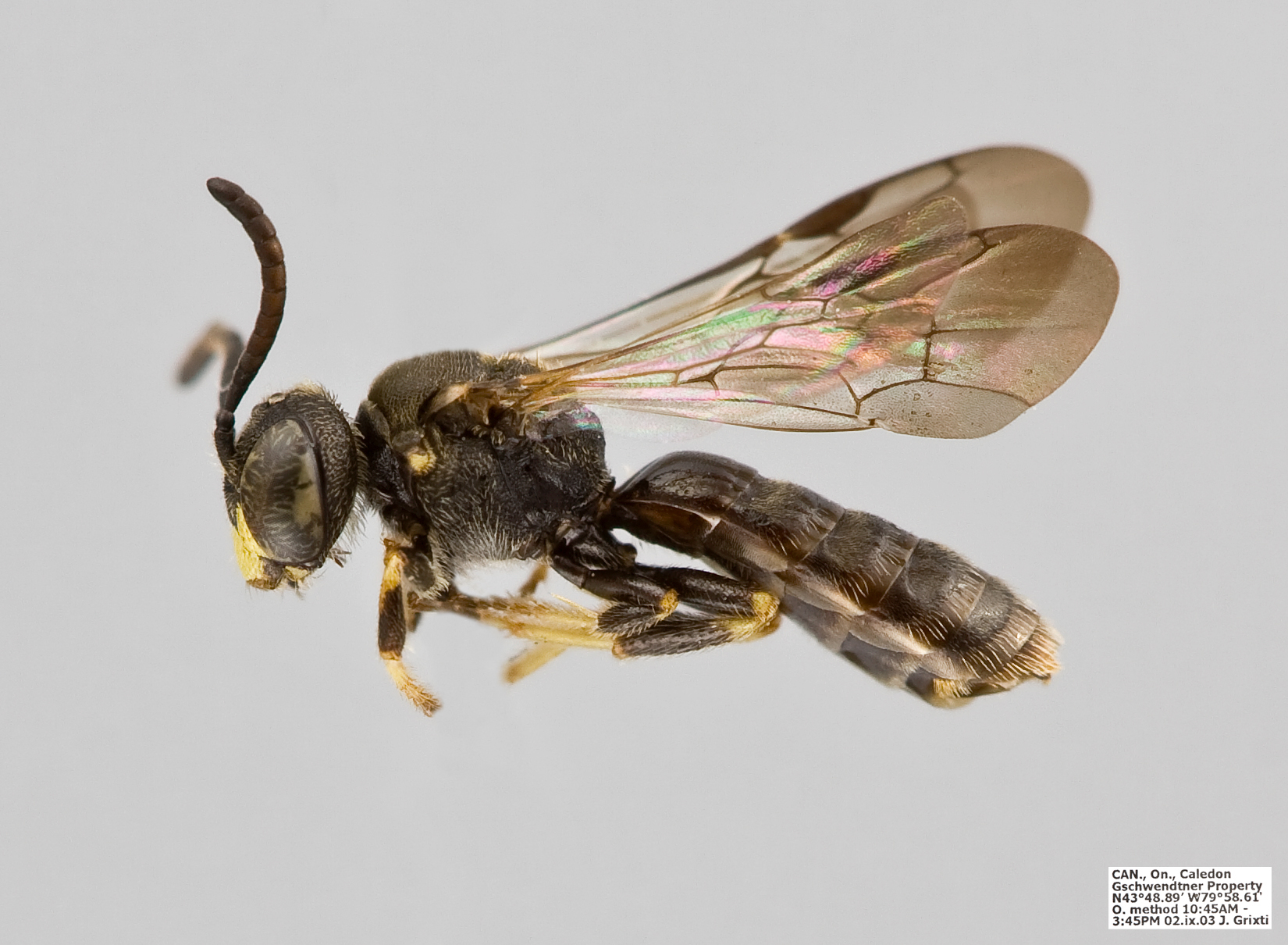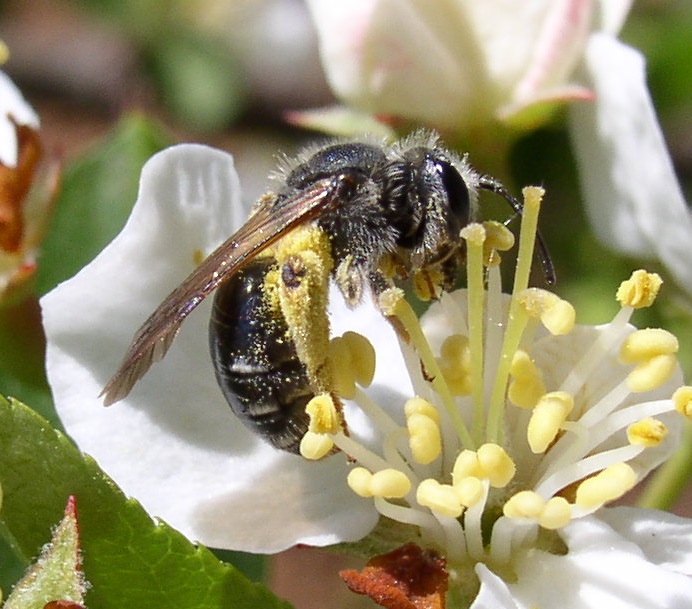|
Anthemurgus
''Anthemurgus passiflorae'' (the passionflower bee) is a small (7.5-8.5 mm long), black, bee that occurs from central Texas to North Carolina and north to Illinois. Females of this solitary bee use collected nectar and pollen to feed larvae located in nests constructed in the ground (through mass provisioning). This uncommon bee is unusual for two reasons: first, the only known pollen host is a single species—the yellow passionflower (''Passiflora lutea'') (such specialization is called oligolecty); second, because of its size and foraging habits, the passionflower bee is thought to contribute little or nothing toward the pollination of its host plant. Female bees remove pollen from ''P. lutea'' by suspending themselves under an anther and scraping the pollen out with open mandibles. This unique position of pollen collection almost never results in pollination as the female bee rarely touches the stigma. The genus ''Anthemurgus'' contains only the passionflower bee and th ... [...More Info...] [...Related Items...] OR: [Wikipedia] [Google] [Baidu] |
Oligolecty
The term oligolecty is used in pollination ecology to refer to bees that exhibit a narrow, specialized preference for pollen sources, typically to a single family or genus of flowering plants. The preference may occasionally extend broadly to multiple genera within a single plant family, or be as narrow as a single plant species. When the choice is very narrow, the term ''monolecty'' is sometimes used, originally meaning a single plant species but recently broadened to include examples where the host plants are related members of a single genus. The opposite term is ''polylectic'' and refers to species that collect pollen from a wide range of species. The most familiar example of a polylectic species is the domestic honey bee. Oligolectic pollinators are often called oligoleges or simply specialist pollinators, and this behavior is especially common in the bee families Andrenidae and Halictidae, though there are thousands of species in hundreds of genera, in essentially all known b ... [...More Info...] [...Related Items...] OR: [Wikipedia] [Google] [Baidu] |
Passiflora Lutea
''Passiflora lutea'', commonly known as yellow passionflower, is a flowering perennial vine in the family Passifloraceae, native to the central and eastern United States. The vine has three-lobed leaves and small, yellowish-green, fringed flowers that appear in the summer, followed by green fruit that turn almost black at maturity. It grows in moist to wet habitats. Description ''P. lutea'' is a perennial, herbaceous, climbing or trailing, unbranched vine that can reach in length. Curled, springlike tendrils emerging from leaf axils help the vine to climb on structures or other vegetation. The leaves are trilobed, long and broad, with a petiole. Leaves have smooth (entire) margins and are alternate on the stem. The upper surface of the leaves is dark green, and may be mottled with splotches of lighter green. In the north of its range, it is deciduous. The showy flowers appear singly or in pairs on slender flower stalks up to long. Each flower is wide with narrow yellowish ... [...More Info...] [...Related Items...] OR: [Wikipedia] [Google] [Baidu] |
Solitary Bee
Bees are winged insects closely related to wasps and ants, known for their roles in pollination and, in the case of the best-known bee species, the western honey bee, for producing honey. Bees are a monophyletic lineage within the superfamily Apoidea. They are presently considered a clade, called Anthophila. There are over 16,000 known species of bees in seven recognized biological families. Some speciesincluding honey bees, bumblebees, and stingless beeslive socially in colonies while most species (>90%)including mason bees, carpenter bees, leafcutter bees, and sweat beesare solitary. Bees are found on every continent except Antarctica, in every habitat on the planet that contains insect-pollinated flowering plants. The most common bees in the Northern Hemisphere are the Halictidae, or sweat bees, but they are small and often mistaken for wasps or flies. Bees range in size from tiny stingless bee species, whose workers are less than long, to ''Megachile pluto'', the l ... [...More Info...] [...Related Items...] OR: [Wikipedia] [Google] [Baidu] |
Mass Provisioning
Mass provisioning is a form of parental investment in which an adult insect, most commonly a hymenopteran such as a bee or wasp, stocks all the food for each of her offspring in a small chamber (a "cell") before she lays the egg. This behavior is common in both solitary and eusocial bees, though essentially absent in eusocial wasps. Diversity In bees, stored provisions typically consist of masses of mixed pollen and nectar, though a few species store floral oils. In a few cases, such as stingless bees and some sweat bees, the number of cells in a single nest can number in the hundreds to thousands, but more typically a nest contains either a single cell, or a small number (fewer than 10). In predatory wasps, the food is typically in the form of paralyzed or dead prey items; after digging the nest they quickly catch one or a few prey animals, bring them to the nest and lay eggs on them, seal the nest and leave. Some wasp lineages (e.g. Crabronidae) show variation, with some spe ... [...More Info...] [...Related Items...] OR: [Wikipedia] [Google] [Baidu] |
Stamen
The stamen (plural ''stamina'' or ''stamens'') is the pollen-producing reproductive organ of a flower. Collectively the stamens form the androecium., p. 10 Morphology and terminology A stamen typically consists of a stalk called the filament and an anther which contains ''sporangium, microsporangia''. Most commonly anthers are two-lobed and are attached to the filament either at the base or in the middle area of the anther. The sterile tissue between the lobes is called the connective, an extension of the filament containing conducting strands. It can be seen as an extension on the dorsal side of the anther. A pollen grain develops from a microspore in the microsporangium and contains the male gametophyte. The stamens in a flower are collectively called the androecium. The androecium can consist of as few as one-half stamen (i.e. a single locule) as in ''Canna (plant), Canna'' species or as many as 3,482 stamens which have been counted in the saguaro (''Carnegiea gigantea'' ... [...More Info...] [...Related Items...] OR: [Wikipedia] [Google] [Baidu] |
Stigma (botany)
The stigma () is the receptive tip of a carpel, or of several fused carpels, in the gynoecium of a flower. Description The stigma, together with the style and ovary (typically called the stigma-style-ovary system) comprises the pistil, which is part of the gynoecium or female reproductive organ of a plant. The stigma itself forms the distal portion of the style, or stylodia, and is composed of , the cells of which are receptive to pollen. These may be restricted to the apex of the style or, especially in wind pollinated species, cover a wide surface. The stigma receives pollen and it is on the stigma that the pollen grain germinates. Often sticky, the stigma is adapted in various ways to catch and trap pollen with various hairs, flaps, or sculpturings. The pollen may be captured from the air (wind-borne pollen, anemophily), from visiting insects or other animals ( biotic pollination), or in rare cases from surrounding water (hydrophily). Stigma can vary from long and sle ... [...More Info...] [...Related Items...] OR: [Wikipedia] [Google] [Baidu] |
Monotypic Taxon
In biology, a monotypic taxon is a taxonomic group (taxon) that contains only one immediately subordinate taxon. A monotypic species is one that does not include subspecies or smaller, infraspecific taxa. In the case of genera, the term "unispecific" or "monospecific" is sometimes preferred. In botanical nomenclature, a monotypic genus is a genus in the special case where a genus and a single species are simultaneously described. In contrast, an oligotypic taxon contains more than one but only a very few subordinate taxa. Examples Just as the term ''monotypic'' is used to describe a taxon including only one subdivision, the contained taxon can also be referred to as monotypic within the higher-level taxon, e.g. a genus monotypic within a family. Some examples of monotypic groups are: Plants * In the order Amborellales, there is only one family, Amborellaceae and there is only one genus, '' Amborella'', and in this genus there is only one species, namely ''Amborella trichopoda ... [...More Info...] [...Related Items...] OR: [Wikipedia] [Google] [Baidu] |
Pseudopanurgus
''Pseudopanurgus'' is a genus of mining bees in the family Andrenidae The Andrenidae (commonly known as mining bees) are a large, nearly cosmopolitan family of solitary, ground-nesting bees. Most of the family's diversity is located in temperate or arid areas (warm temperate xeric). It includes some enormous gene .... There are at least 130 described species in ''Pseudopanurgus''. Pseudopanurgus bees often have 2 submarginal cells in their forewings. Their size range for extra-small to small, 3mm to 10mm See also * List of Pseudopanurgus species References Further reading * * External links * Andrenidae Bee genera Articles created by Qbugbot {{Andrenidae-stub ... [...More Info...] [...Related Items...] OR: [Wikipedia] [Google] [Baidu] |
Andrenidae
The Andrenidae (commonly known as mining bees) are a large, nearly cosmopolitan family of solitary, ground-nesting bees. Most of the family's diversity is located in temperate or arid areas (warm temperate xeric). It includes some enormous genera (e.g., ''Andrena'' with over 1300 species, and '' Perdita'' with over 700). One of the subfamilies, Oxaeinae, is so different in appearance that they were typically accorded family status, but careful phylogenetic analysis reveals them to be an offshoot within the Andrenidae, very close to the Andreninae. C. D. Michener (2007) ''The Bees of the World'', 2nd Edition, Johns Hopkins University Press. Description The Andrenidae are typically small to moderate-sized bees, which often have scopae on the basal segments of the leg in addition to the tibia, and are commonly oligolectic (especially within the subfamily Panurginae). They can be separated from other bee families by the presence of two subantennal sutures on the face, a primitive ... [...More Info...] [...Related Items...] OR: [Wikipedia] [Google] [Baidu] |
Insects Of The United States
Insects (from Latin ') are pancrustacean hexapod invertebrates of the class Insecta. They are the largest group within the arthropod phylum. Insects have a chitinous exoskeleton, a three-part body ( head, thorax and abdomen), three pairs of jointed legs, compound eyes and one pair of antennae. Their blood is not totally contained in vessels; some circulates in an open cavity known as the haemocoel. Insects are the most diverse group of animals; they include more than a million described species and represent more than half of all known living organisms. The total number of extant species is estimated at between six and ten million; In: potentially over 90% of the animal life forms on Earth are insects. Insects may be found in nearly all environments, although only a small number of species reside in the oceans, which are dominated by another arthropod group, crustaceans, which recent research has indicated insects are nested within. Nearly all insects hatch from eg ... [...More Info...] [...Related Items...] OR: [Wikipedia] [Google] [Baidu] |
Pollinator Hymenoptera
A pollinator is an animal that moves pollen from the male anther of a flower to the female stigma of a flower. This helps to bring about fertilization of the ovules in the flower by the male gametes from the pollen grains. Insects are the major pollinators of most plants, and insect pollinators include all families of bees and most families of aculeate wasps; ants; many families of flies; many lepidopterans (both butterflies and moths); and many families of beetles. Vertebrates, mainly bats and birds, but also some non-bat mammals (monkeys, lemurs, possums, rodents) and some lizards pollinate certain plants. Among the pollinating birds are hummingbirds, honeyeaters and sunbirds with long beaks; they pollinate a number of deep-throated flowers. Humans may also carry out artificial pollination. A pollinator is different from a pollenizer, a plant that is a source of pollen for the pollination process. Background Plants fall into pollination syndromes that reflect the type of p ... [...More Info...] [...Related Items...] OR: [Wikipedia] [Google] [Baidu] |







